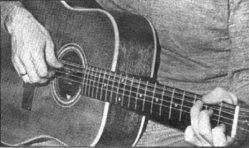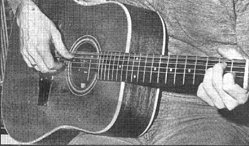Leo Kottke: His Techniques, Guitars, Slide, & Tricks of the Trade
by Gil Podolinsky
Page 2
 |
For me it's always been the 12-string ever since I heard one. It was the only thing I ever wanted to play. No, I take that back. If I could play the lute that [German lutenist] Walter Gerwig plays, I might get into that, but you can't get carried away on the lute as you can on the guitar.
The 12-string is, in a sense, a new instrument. There couldn't have been that many people playing it when you started, so how were you influenced?
You're right. I was still in high school and had been playing for about five or six years when I heard Pete Seeger's "Bells of Rhymney" [World of Pete Seeger, Columbia, CG-31949]. That was my first introduction to the 12-string. Thinking back on it now, it wasn't as great as I had thought at the time. My favorite in terms of sound was Pete's "Banks of Marble" off the Gazette LP [Vols. I and II, Folkways (43 W. 61st St. New York, NY 10023), 2501, 2502]. I also heard Fred Gerlach doing some Leadbelly which just wasn't up my alley. Though I did try to learn these pieces, none of those mentioned influenced my playing.
Did you have a problem switching from 6- to 12-string?
No, I started from scratch. I was mesmerized by the 12-string, for the 6-string had not been a very satisfying instrument for me. Everything just started getting easier when I started playing the 12-string, I think that the instrument in general is easier to play because there are more notes there; more going on. If you're sloppy on a 6-string, you won't be any less sloppy on a 12-string, but in terms of solo guitar, there's more sound to play with, it's more exciting. To me it's like the difference between a piano and an organ. As I say, everything I learned about the guitar on the 6-string made more sense on the 12-string. Lucky thing for me that I started with a good instrument [Gibson B-45, 12-string]. Not doing that, I think, kills most people's interest. If it hadn't been for that guitar, I would have stuck with the 6-string.
 |
Did you practice scales or any particular exercises?
No, never have. I avoided that assiduously. I went through nine years of trombone lessons for that. Formal music instruction is not what a beginning player wants to know or needs to know until he can play. It kills the fun, so I'm glad I didn't do it. I do intend to study when I have the time.
What's your main concern in your approach to the 12-string?
My whole thing is tone. That's more than enough for me. I can listen to a beginner and have my mind blown if he has good tone. It's very hard to find a 12-string with tone, that's why many people don't play them. They're hard to get into pitch and most of them sound horrible. Almost all of them sound silly!